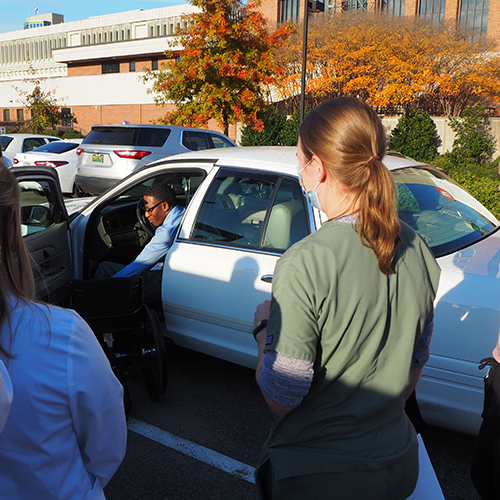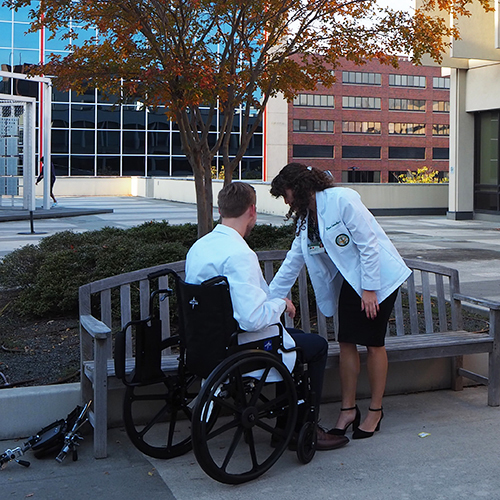
William Brooks, Ph.D., professor and course director for the Musculoskeletal and Skin Module, was inspired to integrate the work of Cathy Carver, PT, ATP/SMS, founder of the Come Roll with Me program, into the MS2 curriculum.
Carver works at Spain Rehab as a physical therapist and outside of her work at UAB, began the Come Roll with Me program in 2016 as an outreach activity for school-aged children to gain awareness of individuals with disabilities.
“The last six years of taking kids out with Come Roll with Me has been life-changing not only for me but for them, too, I think,” Carver said. “The goal has never been understanding— because you won't understand unless you do life with a certain type of disability— but to be more aware, respectful, patient, compassionate, and prepared to help those with disabilities."
Carver participated as a faculty leader and worked with Brooks, wheelchair users, and the Department of Physical Therapy to accomplish this educational activity.
“Some of our students in PT and occupational therapy (OT) and some of the wheelchair users that she works with at Spain Rehab have gone out to some Birmingham area schools and done workshops about wheelchair accessibility and communicating with people who have disabilities,” Brooks said. “We've taken what Carver has done in the community and adapted it for our medical students here on campus.”
The Come Roll with Me activity was part of the medical student’s Musculoskeletal and Skin Module in the second-year medical curriculum. It is one of three activities within the module geared towards interprofessional education related to rehabilitation professions (PT, OT, and speech pathology). The other activities include a panel of individuals in these rehabilitation professions on MSK diseases and another simulation with PT students.
“With Come Roll with Me, we want our students to be aware and be competent in communicating and interacting with individuals with disabilities,” Brooks said. “We're focusing on physical disabilities within our course because it fits the best with what we teach in the Musculoskeletal and Skin Module. We want to help our students become more adept and competent when communicating and working with a patient population that has not just mobility problems, but any type of physical disability, whether it's mobility or other types of physical limitations.”

One station was held on the plaza, where PT students taught the medical students how to perform wheelchair transfers. The PT students had already learned this process in their coursework. This activity allowed them to practice the teaching process of safe wheelchair transfers, preparing them better for teaching this process to wheelchair users while medical students were able to learn how to conduct wheelchair transfers for their future patients. During the exercise, wheelchair users shared their experiences with transfers in medical offices.
“I think these types of trainings work towards closing the knowledge gap between healthcare providers,” said MS2 Channing Bruce. “While a doctor cannot aim to do everything a physical therapist does and vice versa, there should and will be a lot of overlap in patient care. I think physicians need a better understanding of what other healthcare disciplines do daily to better serve their patients and work better on an interprofessional level.”
The second rotation was in the parking lot outside Volker Hall where several wheelchair users parked their accessible vehicles in the handicapped spots. Each group listened as the wheelchair users talked about navigating sidewalks, navigating crosswalks, how to use a lift within an accessible vehicle, and general barriers that come with getting around an urban environment.
“One of the things we talked a lot about was advocating for our patients with insurance companies in order to get them better wheelchairs and home devices to decrease strain on their bodies,” Bruce said. “I want to be well-equipped to do this for them, and I consider it a duty as a physician to do so.”
The third rotation was an obstacle course within Volker Hall, where each student was put into a wheelchair and navigated through the building, using doors, bathrooms, water fountains, and ramps. This activity was meant to show limitations and barriers and general challenges with self-propelling a wheelchair through a building and raise awareness of how we can have our clinics and buildings made more accessible.
“With a new awareness of my surroundings and the challenges wheelchair users face in navigating certain environments, I plan to ensure that my future practice is accessible to all patients,” said MS2 Emily Hooker.

“I plan to address health inequity by listening to my patients and continuing to learn from them,” said Schuyler Buckner, a 2nd year DPT student. “They are the experts on what life is like for them, and I have to listen to them before I can do anything to assist them. I plan to be an advocate for my patients and be an ally for them, working with them to find solutions to challenges they may face.”
Karneshia Patton, a UAB patient and wheelchair user, has participated as an educator in the Come Roll with Me program, including this activity, and shared what it means for her and other wheelchair users to be involved in training activities such as this.
"This [activity] is very helpful, especially since people with disabilities are included in the process,” Patton said. “Our voices need to be heard on what we need from the healthcare facilities. I’m thankful for Come Roll with Me to include us in the process of having better and accessible care for people with disabilities."
Many students expressed the personal impact and benefit to their training that this activity had on them.
“I think health equity training is essential for healthcare providers to establish positive, professional relationships with people of a variety of physical abilities, characteristics, and backgrounds.,” said Vanessa Smith, a second-year SPT. “By maintaining cultural awareness and checking our own implicit biases, we become much better equipped to serve others with the care they need, when they need it.”
Other students expressed that while this first Come Roll with Me activity in the School of Medicine is a step in the right direction, there is a desire for additional training in health equity and accessibility to care.
“I think that this implementation of health equity training is a good start, but more needs to be done,” said MS2 Thompson Butler. “I would love to have more training so that I can lend a hand while on the wards. The more knowledge I have, the more knowledge I will be able to provide to others.”

“I think that we as educators need to move with our culture to provide training on health equity and access to care to our students that they are expecting nowadays,” Brooks said. “And that's only going to be beneficial for everybody. If we accomplish that, the students benefit, we benefit as teachers, and the patients will benefit ultimately, as well.
The Heersink School of Medicine intends on integrating more disability care training into its curriculum, focusing on the heart of health equity and improved access to care.
“We're all human, some people roll on wheels, some people walk in shoes, some people use a cane or a walker, but we're all people,” Carver said. “I think true inclusion means bringing everyone into the same room, hearing how we can better improve access to health care with all kinds of disabilities and be more aware of what they need.”